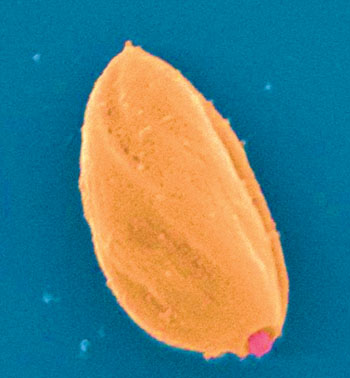Paper-Based Microfluidics Developed for Molecular Diagnostic Testing
By LabMedica International staff writers
Posted on 01 Apr 2014
A low cost, safe, disposable, rapid and self-sustainable paper-based platform for diagnostic testing, known as lab-on-paper, has been developed. Posted on 01 Apr 2014
Such diagnostic tests are in high demand, targeting diseases such as tuberculosis and leishmaniasis, mainly in the developing world, where they remain major impoverishment factors for local communities and there is a strong interest in the use of biopolymers in the electronic and biomedical industries, towards low-cost applications.

Image: Colored scanning electron micrograph of a Leishmania mexicana amastigotes (Photo courtesy of Zephyris).
Scientists at the Universidade Nova de Lisboa (Lisbon, Portugal) have developed paper-based microfluidics for molecular diagnostic testing. Paper properties were evaluated and compared to nitrocellulose, the most commonly used material in lateral flow and other rapid tests. They focused on the use of paper as a substrate for microfluidic applications, through an eco-friendly wax-printing technology, with three main and distinct colorimetric approaches: enzymatic reactions, immunoassays, and nucleic acid sequence identification.
Colorimetric glucose quantification was achieved through enzymatic reactions performed within specific zones of the paper-based device. The coloration achieved increased with growing glucose concentration and was highly homogeneous, covering all the surface of the paper reaction zones in a three dimensional (3D) sensor format. These devices showed a major advantage when compared to the 2D lateral flow glucose sensors, where some carryover of the colored products usually occurs.
The detection of anti-Leishmania antibodies in canine sera was conceptually achieved using a paper-based 96-well enzyme-linked immunosorbent assay format. However, optimization is still needed for this test, regarding the efficiency of the immobilization of antigens on the cellulose fibers. The detection of Mycobacterium tuberculosis (MTB) nucleic acids integrated with a non-cross-linking gold nanoprobe detection scheme was also achieved in a wax-printed 384-well paper-based microplate, by the hybridization with a species-specific probe. The whole process, including the polymerase chain reaction (PCR) amplification step, takes less than two-and-half hours, which is considerably faster than traditional methods.
The authors concluded that they obtained results with the easy-to-use diagnostic biosensors that show promise towards the future development of simple and cost-effective paper-based diagnostic devices. In future studies, they will simplify the paper-platform assay for MTB by the elimination of the polymerase chain reaction step, which depends on the use of thermocycler equipment and its replacement by an undemanding isothermal DNA amplification such as loop-mediated isothermal DNA amplification (LAMP). The study was published on February 12, 2014, in the journal Nanotechnology.
Related Links:
Universidade Nova de Lisboa










 (3) (1).png)


